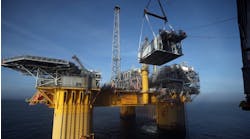Kevin McMillin
Houston
Technology advancements driven by scientists or artists?
An artisan, as defined by Webster's New Collegiate Dictionary, is "one trained to manual dexterity or skill in a trade." The oil and gas industry has always been populated with individuals whose life-long experiences in their respective trades fueled the industry's growth. We rely on these individuals and their knowledge to guide us through problem-solving phases of product development.These artisans set the standard for performance and creative invention in a work environment of wood, mud, oil, iron, and steel. From the early days of "making hole" with cable tool rigs and wood derricks, creative solutions, like adding chopped up indigenous wildlife for lost circulation material to the mud system, stimulating wells with dynamite, logging wells with simple electric currents, and eventually breaking the land barrier to drill a well on the ocean, were performed. It was these unique approaches to problems, and the imaginative artisans who made them happen, that led the charge into the unknown, taking the industry step-by-step into the future.
What we now call "technology" is simply the realization of a few creative artisans' ideas. Ideas which probably appeared crazy to some, but seemed to always make things easier. In the past, artisans dictated the development of industry knowledge, with science building on these ideas and providing the avenue for technological advancement. Science now seems to dictate where and how gifted artisans' skills will be utilized. The electronics and computer age have given the industry unlimited possibilities for product invention and development, putting the pressure back on the skilled artisan to make the new technologies work.
The directional drilling profession is a good example. Directional drillers (DDs), which emerged as inventive and rig knowledgeable personnel, were asked to conduct and supervise more involved drilling operations.
Familiarity with the tools of the profession and a unique ability for being creative, made DDs a key factor in drilling tool development for several decades. Their creative and practical approaches to problems pointed the way to functional, fit-for-purpose, equipment. Technology today gives DDs the ability to monitor and steer drilling assemblies in three dimensions. This most certainly would have amazed their early artisan predecessors, who made the impossible happen within a "one dimensional" world - drill in the hole, and trip out.
One of the latest buzz phrases in the industry is "intelligent systems." All aspects of the oil industry are experimenting with intelligent systems. Intelligent completions have already been achieved on a small scale. Intelligent drilling systems, implemented in new rotary steerable drilling tools, are in their infant stages of development. The tools contain pre-programmed information and can manipulate themselves to stay within tolerances of this information - while maintaining the ability to change this pre-programmed information realtime.
Science and technology have become more a part of the decision-making process in the drilling industry. Artisans' experience and knowledge have been depended upon to prevent and deal with problems. Science and technology have made the problem solving part of our industry more predictive, and hopefully more cost effective.
Integrated management approaches transforming service industry
The recent flurry of mergers and acquisitions among oil and gas industry companies has dominated the news in recent months. This goes hand-in-hand with the recent trend in changing how companies are structured and present themselves to customers. A recent buzz phrase in corporate America is "solutions and products." Large and small companies alike have restructured themselves to better service their customers in this new environment.All aspects of corporate structure are aligned to gain full benefit from a more focused problem solving culture. The oil and gas industry has not been immune to this trend in corporate transition. In fact, some service companies have already adopted this structure to help them address customers' specific needs. In an industry growing so rapidly, and spreading into remote areas, this type of corporate structure allows for more flexibility of services.
Some service providers have formed independent groups, specifically for managing entire integrated services projects. Operators are continuing to give more control of operational engineering and management to service companies.
The main purpose of the focused groups is to optimize the planning and decision making processes of these added responsibilities. The benefits to operators include more efficient health, safety, and environment management at their rig sites, easier financial billing and accounting, and fewer assets and personnel required for project management.
This trend has yielded a smaller, integrated technologies approach to address single well site management. The difference in this approach is more focus on technology management as opposed to total project management. M-I Drilling Fluids has introduced an integrated approach to well site fluids management. The program, called Integrated Fluids Management (IFE), is a planning-for-production approach, which includes fluids engineering to waste management. This management approach is highly applicable when drilling in remote, hard to access locations and in sensitive wilderness and wildlife areas. This approach has allowed M-I to address clients' demand for more unification of existing miscellaneous well services. The alignment of goals with client objectives allows for "pay for performance" pricing. This is advantageous for both the service and operating companies.
Other examples of this trend are prevalent in the industry as "alliances." This technique was introduced in recent years to better align service providers and operators in addressing specific operational problems. Usually specific to a geographic region and client, it has proven to be an effective technique for optimizing operating efficiencies, and laying the foundation for what we today see in integrated services.
Copyright 1999 Oil & Gas Journal. All Rights Reserved.


